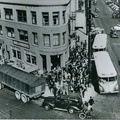Read Part 25 >>
ISSEI PIONEERS
For many Issei, their temporary stay had stretched into ten, twenty years and more, with the youth they had brought to America now spent.
One Day
I found my father
In the mirror.1
Some found "money trees" and returned to Japan. Others migrated to Mexico of Manchuria looking for better opportunities. Many more decided to sink their roots and settle in America.
Getting used to it,
America, now for me
The best place to live.2
Quite a few died alone in cheap boarding houses and nursing homes with no one to care for their ashes, no children to carry on their family names, too ashamed to tell their worried families in Japan about their hapless misfortunes.
On top of failure,
Piling up all my worn-out
Dreams of great success.3
“You Will Be Remembered” wrote Rose Kitahara on the last pages of her father’s diary which spanned thirty years, from the time of his arrival in San Francisco, December, 1916 and until after the war in July, 1946. The tribute she wrote to her Issei father, Sakui Bannai, speaks eloquently of the Issei Pioneers and the legacy they left behind.
He lived 81 yrs., a simple gentle and brave life, not remarkably unique from other immigrants’ histories & yet a story worthy of being remembered for the generations that follow. Mostly at present a loving reminiscence for the children and grandchildren but in the perspective of later years a lesson in nobility and courage. Though he is gone and missed he deserves to be remembered and cherished so we can recall him as he was, not enlarged or embellished (for ostentation had no part in his honest life).4
Faced with racism and discrimination that kept them from becoming equal members of American society, the Issei fought to improve the quality to their lives. They made great personal sacrifice to raise their children, worked hard to build communities, and influence the growth of the regions where they lived. Branded by the highest court of the land as “aliens ineligible to citizenship,” their future now lay in the hands of their Nisei children.
(END)
Notes:
1. Kyusei Mochizuki, Hokubei Senryo Jisen Kushu (Seattle: Hokubei Hochisha, 1957), translated by Sachiko Honda, “Issei Senryu.” In Gail Nomura et al. (Eds.), Frontiers of Asian American Studies, p. 176.
2. Dontsuku, Ito, Issei, p. 762.
3. Katsuko, Ito, p. 772.
4. Rose Ktahara, April 29, 1978, written in the diary of Sakui Bannai, December
5. 1916 to July 1946, Courtesy of Rose Kitahara and the Bannai Family Collection, Japanese American National Museum.
* Issei Pioneers: Hawai‘i and the Mainland, 1885-1924 is the catalogue accompanying the National Museum’s inaugural exhibition. Using artifacts from the National Museum’s collection to tell the story of the courageous “Issei Pioneers,” the catalogue focuses on the early immigration and settlement years. To order the catalogue >>
© 1992 Japanese American National Museum





